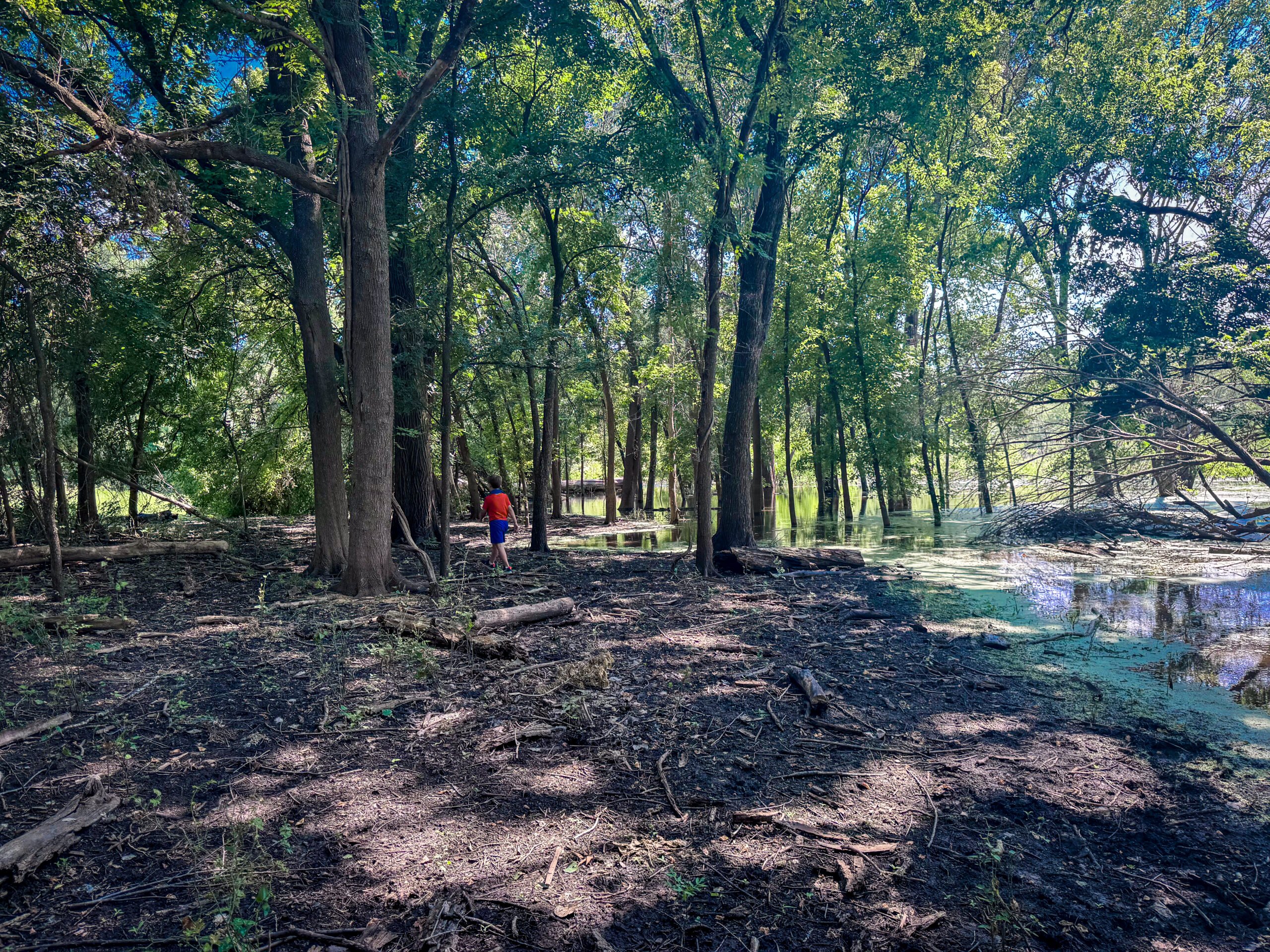If you’re in the stage of life of life where you’ve had kids and now you’re trying to figure out how to get back to adventuring the world again, we’ve got you. In this guide, I’ll talk about how to plan an itinerary for a family, budgeting, tips for making the adventure as smooth as possible, and more.
What is Family Adventure Travel
We consider adventure travel to be a trip that gets our kids outside and exerting some physical activity while exploring nature or a remote destination. This is admittedly quite a bit less adventurous than most of the activities we post about on We Seek Travel, but for a child, anything can seem adventurous.
Once, while we were camping not far from our hometown, we came across part of the campground that was unexpectedly flooded, blocking our planned path through the grounds. Our kids found this thrilling to explore, as we explored the area through the trees along the edge of the bog. Our son led the way as he tried to figure out a path and our daughter followed along, while we hung back a bit to let them have some independence. So while we’re not quite at the age of multiday hikes or canyoneering, we’re discovering that adventure isn’t defined by distance or difficulty, but by their perception. And the more thrilling activities will come with time.
Why Adventure with Kids?
If you’ve come across We Seek Travel, you probably already have a personal love of travel, and you know how you benefit from it as an adult. It may be reconnection with nature, the appreciation and gratitude that comes with meeting people from different cultures, the adrenaline rush of taking risks and the sense of accomplishment for having completed a difficult task.
Kids get all these same benefits, but they have the added bonus of highly plastic brains with still-developing neural networks. In other words, the experiences they have traversing the world at a young age can help shape the way they function in everyday life in a very powerful way. One of the best gifts I can give my kids is the exposure to cultures outside their own and challenges that build their confidence and resilience.
As parents, we get the joy of seeing this excitement and personal growth first-hand; and as a family on a trip together, we get to spend time together without the distraction of screens and homework and after-school sports. It’s not to say that the journey is ever perfect - there are always moments of frustration, fatigue, and lots of bickering between our 4- and 8-year-olds. But we truly never remember those moments looking back on the trip.
How to Plan an Adventure Trip with Kids
Here are the nuts and bolts of how to choose a destination and develop the trip itinerary:
Picking a Travel Destination for a Family
I don’t currently have a list of best places to take kids, because there are so many, and the best place to travel with your family probably depends on where your hometown is. If your kids are not already avid flyers, or if they're in the baby/toddler age group, I would start with destinations close by. National parks in your home country are perfect for adventurous family trips.
We personally don't start by Googling "family-friendly trips" when choosing a destination; rather, to decide if it's a trip the whole family will take, we consider: 1) where my wife and I want to visit; 2) the activity we want to experience at that destination; 3) cost; and 4) safety.
For instance, while we'd love to visit Africa, many safari operators have a minimum age of 6 - not quite there yet for our youngest. Then we get to cost, which can be astronomical for a family of four. So we will still probably wait until our youngest is at least 8 and can fully enjoy the trip, since it may be once in a lifetime.
Costa Rica, on the other hand, has plenty of activities for all ages, is an easy and relatively cheap flight from the U.S., and is overall safe for tourists. Other popular destinations (some of which we have done or are planning to do with our own kids) for family-friendly adventure travel include Iceland, Croatia, Thailand, New Zealand... but as I mentioned above, there are no shortage of options.
Regarding safety - crime can happen anywhere. But if we're considering dense cities where crime is known to be higher risk, we’re probably not going to venture there with our kids until they’re older. Parents who are clearly tourists distracted by their busy kids are likely to be easy targets for pickpockets. I'd prefer to wait until I'm not trying to keep one eye on the four year old while navigating a foreign city.
Choose Age-Appropriate Adventures
It goes without saying, but your toddler should not be bungee jumping. Plan activities according to your kids’ ages and add a little more each trip. Additionally, don't overdo it on the plans. When we’re traveling as a couple, we tend to pack our days with activities to make the most of our time abroad. With young kids, though, we have found that our day works best when we only plan for one “big” activity per day, and leave the rest open for free time, naps, family game time, etc. This gives us a great balance and keeps our trips exciting but limits fatigue-induced meltdowns.
We generally get up and going early in the morning for a hike, kayaking, whatever the plan is for that day. We try to leave the late afternoon and evening more open, depending on what the kids' energy levels are like. Often, we opt to stay in an accommodation with a kitchen to cook dinner rather than going out (both to save money and because the kids are usually done by that point).
Here are a few outdoor activtity ideas by age level. Of course, your kid's developmental level may vary.
Toddlers - short hikes (or longer hikes if you plan to carry), riding along in a toddler seat on a bike, wildlife viewing, swimming at a calm beach, camping
Younger school-age - longer hikes, easy biking, snorkeling, surfing, skiing/snowboarding
Older school-age - even more challenging hiking and biking, zip-lining, white-water raffling
Adolescents - bungee jumping, skydiving, remote overnight treks, mountaineering
Tip: As parents, we know that sometimes we have to prepare not only the adventure itself, but also activties to keep kids engaged and whine-free along the way. Check out our tips for hiking with kids where we discuss this in detail.
Logistics for Family Travel
Secure Reliable Travel Insurance
It's always smart to insure your trip and especially your health, even for short itineraries. While many travel credit cards include trip cancellation and lost baggage insurance, medical expense coverage is not as common. We think it's always wise to purchase a short term policy that covers medical expenses in case of emergency. We have heard too many horror stories of travelers incurring tens of thousands of dollars in emergency medical expenses when traveling abroad to not spend a little extra on insurance. Even something as simple as a GI bug can easily land a younger kid in the hospital for dehydration. Some insurance policies offer free or discounted rates for children.
Tip: If you do have a travel rewards credit card, carefully check the terms regarding insurance coverage and understand them before you ever travel. Benefits will also vary by the home country of the cardholder; our Amex Platinum, for instance, does not include medical expense coverage as a U.S. based cardholder, but that is a benefit for members from other countries such as Canada.
Health Prep
- Schedule a pre-travel checkup for kids (especially before long-haul trips) and ensure immunizations are up to date at least a couple of weeks before your departure.
- Pack basic meds: fever reducer, motion sickness tablets, allergy meds, and rehydration salts. We use this pocket pharmacy to organize medications.

- Bring original bottles for prescriptions and a note from your pediatrician if needed.
- Check laws regarding prohibited substances in your destination country. Some medications are banned in certain countries even if prescribed (e.g., Adderall is illegal in Japan, Vyvanse requires pre-arrival approval in Thailand).
- Pack bug repellent, sunscreen, and hats, especially in tropical climates.
Travel Documentation
Keeping track of twice as many travel documents while also trying to wrangle kids at the airport can be challenging. Ideally, one parent keeps all the documents in a family travel wallet (or even just a zipper bag) while the other parent keeps an eye on the kids. Keep digital backups and printed copies of passports, birth certificates, insurance details, and emergency contacts.
Transportation
Bring a portable car seat or booster as car seats may not be readily available otherwise. We used the RideSafer Vest for years before our daughter graduated to a booster seat, and now we use an inflatable booster. The vest takes practice learning how to install it properly, but once we had it down, it was much more convenient than some of the bulky travel car seat options like the WAYB.

Always use reputable transport services or vetted local drivers. When we are booking transportation services, we prefer using GetYourGuide or Viator where we can see honest reviews for an added layer of reasurance.
If renting a car, look up the insurance policies of the destination country (don't assume they will accept the coverage your own insurance or credit card provides). When you pick up the car, remember to take photos to prove the current state, especially of any scratches and dings, and confirm seatbelts and safety features before driving off. Download offline maps ahead of time, and mark your accommodations, hospitals, and major landmarks before heading out.
Communication
Carry a local SIM or eSIM for reliable connectivity, and provide your emergency contacts your accomodation and itineray details.
Budgeting for a Family Adventure Trip
Traveling with a family of four can get expensive fast. Here are a few tips on how to make the trip more affordable.
Save on Transportation
- Learn how to get the best value for your credit card points to book your flights. If you’re the type to plan a year in advance, you should be able to get great award seats without too much trouble (though some destinations are more challenging than others due to popularity). We typically aren’t planning quite that far in advance, but are usually still able to book award seats using an award travel search engine with alerts like PointsYeah.com.
- Try to be flexible with your travel dates when possible. Especially when booking with points, we've found adjusting our travel dates by a few days one way or another can make hundreds of dollars worth of difference. Let the kids miss a few days of school for a better flight - the experience is more than worth it.
- Take public transportation when possible. Admittedly, this can be stressful with little kids with lots of gear; but at least once the luggage is settled at your hotel, taking public tansportation during your trip can save a ton of money.
- Pack as light as possible to save on checked bag fees and make getting around with your luggage overall less stressful. If you know you always check bags, make use of an airline credit card that includes free checked luggage as a benefit (we have the AAdvantage Viator Red World Elite Mastercard, which gives every person on our ticket one free checked bag).
Save on Accomodations and Dining
- Book a house or apartment with a kitchen when able. You’ll save a ton by preparing some meals yourself, and generally will have extra room to spread out for the whole family.
- Bring all the snacks from home, or stop at a grocery store or local market at your destination. Buy in bulk and package snacks in indidivdual reusable bags whenever you can, so you never find yourself spending $8 for a muffin at the airport.
- Travel in the off season or shoulder season when possible for better accomodation rates.
- When dining out, ask for local restaurant recommendations rather than tourist hot spots.
Save on Family Outdoor Activties
- Choose self-guided tours and simple outdoor activities like hiking, biking, and camping over pricier guided tours. National parks are great for families as the entrance fee is usually quite reasonable, and often discounted for kids.
- When the guided tour is worth it (say, wildlife viewing), look for discounted child rates.
Packing Checklist for Family Travel
Outdoor Essentials
- Daypacks
- Reusable water bottles or hydration bladders
- First-aid kid - include pediatric doses of meds, blister care, and motion sickness tablets
- Quick-dry towels
- Headlamps or compact flashlights
- Reusable baggies/snack containers
- Sun protection
- Rain jackets/ponchos
Baby/Toddler Supplies
- Child carrier backpack
- Lightweight stroller - one that folds easily and handles uneven terrain. Alternatively, consider renting a sturdier jogging stroller at your destination to save the hassle at the airport.
- Travel crib or portable bed rail
- Diapers, wipes, diaper cream, changing pad
- Portable blackout shades (a game changer for hotel naps)
Kid Supplies
- Sturdy hiking shoes
- Mini backpack to carry their own things
- Travel journal or sketchpad
- Binoculars or magnifying glass
Clothing
- Base layers: moisture-wicking shirts, leggings
- Insulating layer: fleece or light puffer jacket
- Outer layer: waterproof shell or windbreaker
- Swimsuits + rash guards
- Multipurpose shoes: trail runners or sandals that handle wet and dry terrain
- Extras: hats, sunglasses
Everyday Essentials
- Chargers, adapters, and portable batteries
- Toiletries
- Camera
- Color-coded packing cubes to keep it all organized by person
Tips to Making Family Travel Stress-Free
- Keep the itinerary flexible. Traveling with kids takes twice as much planning, but requires three times as much flexibility than traveling alone or with a partner. We thoroughly research activities at our destination to know what the options are for our kids' ages and ability levels, but we only book what we need to in advance. We prefer to keep a general outline of our itinerary while taking it one day at a time while on the trip, assessing everyone's fatigue levels and capabilities along the way.
- Mix adventure with downtime. We plan for a maximum of one "big" activity (hiking, biking, ziplining, etc) each day, and leave the rest of the day open for rest and just spending time together. We're big on games in our family, so we usually bring a few card games that are easy to to pack. It can be tough to find games both our kids enjoy since they're four years apart, but here are a few we all enjoy right now:
- Let kids help plan activities. If they're old enough, let them help plan some of their "must-do" activities before the trip to get them invested. When there's flexibility in the itinerary, parents can give the kids choices of what they'd like to do on a particular day.
- Prepare, but don't overpack. We used to have a tendency to try to pack for every possible situation and need, along with every modern convenience our kids were accustomed to, but overpacking creates much more of a mess when you're multiplying the stuff times four. We try to limit the luggage to only the essentials plus a few lightweight entertainment items, and we pack fewer clothes than the trip calls for and wash along the way. Packing cubes also help when keeping track of everyone's things.
Resources
- Favorite booking sites for adventure families: GetYourGuide, Viator, Booking.com
- Travel insurance options: HeyMondo, World Nomads
- Recommended travel apps: TripIt, TravelSafe SOS
Final Thoughts
Traveling with kids can feel overwhelming at times, but in the end, the effort is more than worth it. Travel introduces our kids to other worldviews, helps them build confidence, and reminds us that adventure doesn’t end when we become parents. Whether it’s a weekend hike or a month abroad, every shared experience deepens our connection as a family and widens our sense of wonder for the world.




